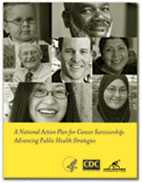The National Action Plan for Cancer Survivorship
CDC and the LIVESTRONG Foundation led a public health effort to address the issues faced by the growing number of cancer survivors living with, through, and beyond cancer. Through their collaboration, A National Action Plan for Cancer Survivorship: Advancing Public Health Strategies [PDF-1MB] was developed.
The National Action Plan represents the combined effort of almost 100 experts in cancer survivorship and public health. It identifies and prioritizes cancer survivorship needs and proposes strategies for addressing those needs within four core public health domains–
- Surveillance and applied research.
- Communication, education, and training.
- Programs, policies, and infrastructure.
- Access to quality care and services.
A Public Health Approach
Survivors face numerous physical, psychological, social, spiritual, and financial issues at diagnosis, during treatment, and for the remaining years of their lives. Many of these issues may be addressed successfully through coordinated public health initiatives.
The National Action Plan takes a comprehensive approach, focusing on the impact of cancer on the entire population and emphasizing collaborative, community-based activities. A public health approach includes influencing the health care system, providers, and policy makers who support and can make a difference in reducing the burden of cancer on survivors.

Purpose of the National Action Plan
The National Action Plan charts a course for how the public health community can address cancer survivorship more effectively and comprehensively and focus on improving the quality of life for survivors. This plan includes the following goals—
- Preventing secondary cancers and recurrence of cancer whenever possible.
- Promoting appropriate disease management following diagnosis and treatment to ensure the maximum number of years of healthy life for cancer survivors.
- Minimizing preventable pain, disability, and psychosocial distress for those living with, through, and beyond cancer.
- Assisting cancer survivors in accessing family, peer, community support, and other resources they need for coping with their disease.
23 Identified Needs
The following list includes five cross-cutting and 18 priority needs that were identified through the development process. Strategies for addressing these needs are detailed in the National Action Plan.
Cross-Cutting Needs
- Develop an infrastructure for a comprehensive database on cancer survivorship.
- Develop, test, maintain, and promote patient navigation systems that can facilitate optimum care for cancer survivors.
- Establish and disseminate clinical practice guidelines for each stage of cancer survivorship.
- Develop and disseminate public education programs that empower cancer survivors to make informed decisions.
- Conduct ongoing evaluation of activities to determine their impacts and outcomes and ensure continuous quality improvement of services.
Priority Needs
- Enhance the existing surveillance and applied research infrastructure.
- Identify factors associated with ongoing health concerns of cancer survivors.
- Determine programs and services that best address the needs of cancer survivors.
- Conduct research on preventive interventions to evaluate their impact on issues related to cancer survivorship.
- Translate applied research into practice.
- Develop strategies to educate the public that cancer is a chronic disease people can and do survive.
- Educate policy- and decision-makers about the role and value of providing long-term follow-up care, addressing quality-of-life issues and legal needs, and ensuring access to clinical trials and ancillary services for cancer survivors.
- Empower survivors with advocacy skills.
- Teach survivors how to access and evaluate available information.
- Educate health care providers about cancer survivorship from diagnosis through long-term treatment and end-of-life care.
- Identify and implement programs proven to be effective (i.e., best practices).
- Implement evidence-based cancer plans that include goals and strategies for all stages of cancer survivorship.
- Promote policy changes that support addressing cancer as a long-term, chronic disease.
- Develop infrastructure to obtain quality data on all cancer management activities to support programmatic action.
- Educate decision-makers about economic and insurance barriers related to health care for cancer survivors.
- Establish and disseminate guidelines that support quality and timely service provision to cancer survivors.
- Assess and enhance provision of palliative services to cancer survivors.
- Establish integrated multidisciplinary teams of health care providers for cancer patients.
Outcome
The primary outcome of this National Action Plan was to establish a greater awareness among the general public, policy makers, researchers, advocates, and survivors of the role public health can play in advancing cancer survivorship issues, and realizing the need to take action among organizations. Organizations that take action to implement the proposed strategies can ultimately improve the overall experience and quality of life of the millions of Americans who are living with, through, and beyond cancer.
Smith JL, Pollack LA, Rodriguez JL, Hawkins NA, Smith T, Rechis R, Miller A, Willis A, Miller H, Hall IJ, Fairley TL, Stone-Wiggins B. Assessment of the status of a National Action Plan for Cancer Survivorship in the USA. Journal of Cancer Survivorship 2013;7(3):425–438.
- Page last reviewed: May 30, 2017
- Page last updated: April 2, 2015
- Content source:
- Maintained By:


 ShareCompartir
ShareCompartir